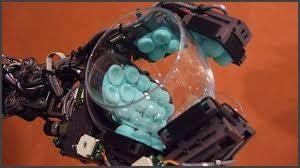Teaching in a FIRST Robotics Classroom
 Kids these days are sharp! I was reminded of this fact during an opportunity to teach SOLIDWORKS to Macomb County FIRST Robotics teams “Thunder Chickens” and “I AM Robot”. Having spent my first five years at Fisher Unitech teaching and supporting SOLIDWORKS, the front of a classroom is familiar territory. Plus, a roomful of kids was a welcome change of pace (and an opportunity to be the oldest guy in the room for a change). I am glad I accepted their invitation.
Kids these days are sharp! I was reminded of this fact during an opportunity to teach SOLIDWORKS to Macomb County FIRST Robotics teams “Thunder Chickens” and “I AM Robot”. Having spent my first five years at Fisher Unitech teaching and supporting SOLIDWORKS, the front of a classroom is familiar territory. Plus, a roomful of kids was a welcome change of pace (and an opportunity to be the oldest guy in the room for a change). I am glad I accepted their invitation.
I typically begin my classes by explaining my objective: to present the material as clearly and coherently as I am able; and my expectations of the class: to be attentive and engaged. But in this case, such a preamble seemed superfluous. These students were, after all, here by choice.
After spending a full day at school at the Utica Center for Science and Industry  (Thunder Chickens), and the International Academy of Macomb (I AM Robot), the kids were willing to stay late into the night to learn skills that would later be applied during long work sessions and gruelling competitions—outside school hours, and unpaid. They had come to learn, and to work hard at it. These are future engineers and entrepreneurs in the making, many of whom will go on to use SOLIDWORKS in their careers like the inventors at Robot Rebuilt.
(Thunder Chickens), and the International Academy of Macomb (I AM Robot), the kids were willing to stay late into the night to learn skills that would later be applied during long work sessions and gruelling competitions—outside school hours, and unpaid. They had come to learn, and to work hard at it. These are future engineers and entrepreneurs in the making, many of whom will go on to use SOLIDWORKS in their careers like the inventors at Robot Rebuilt.
The 2017 First Robotics Competition begins January 7th. That’s when teams of high school students around the world find out what challenge their robot must solve this year. In just seven short weeks, the teams must design, build, and test their robot, before weekly competitions begin in March. Teams face off through seven rounds of competition, putting their bot to test, all the while troubleshooting and improving their designs.
Most students in my classes compete all four years, then return to mentor their teams. I could gush for pages about how sharp these kids are, and how quickly they were able to pick up the subject matter. But something about the timing of these classes brought a unique perspective to the experience.
The first class I taught fell during the tumultuous final weeks leading up to the US election, with the second landing squarely in peak holiday shopping season. In both cases, the soundtrack to my commute was punctuated by the same message: Out with the old; in with the new. Government not working the way you want? Elect someone new! Smartphone running a bit slow? Buy a new one (and a matching tablet)! Reality got you down? Try a virtual one! A cacophony of talking heads telling us what to want and who to believe; the voice of reason barely audible. It is tempting to rant; to shake my fist and shout into the noise, as if my breath could stop the whirlwind. What difference would that make? What difference can I make?
Then I am reminded of these students. High school kids foregoing video games and movies and all the trappings of commercialization, to cultivate their minds. What an inspiration! And when I see their passion for learning, I remember my own. I remember the inquisitive spirit which drove me to pursue engineering. And I remember the mentors in my life who inspired that in me. I remember their voices, and the answer comes into focus.
We engineers and architects, designers and draftsmen, toolmakers and tool users; we have voices too. We can get involved in programs like FIRST. We can volunteer at schools and clubs, and share our passion with students. Online, in passing, or at the dinner table, our conversations can inspire. The media we choose to consume and discuss, the gifts we choose to give, and the time and money we spend all convey our priorities and set an example.
When we encourage problem-solving and curiosity, we help to equip the next generation with tools to address the new challenges they will face. If we use our voices to encourage and empower analytical minds, that message can resonate for a lifetime.

About the Author
Dan Erickson is a student of life. With a BS in Mechanical Engineering Technology from Michigan Tech University and a penchant for tinkering, he is driven to understand how the world works and improve wherever possible. After several career iterations, Dan came to Fisher Unitech in 2011 as a SOLIDWORKS Support Engineer. He has since followed his passion for transformative technology to the 3D Printing department, supporting the Sales and Marketing teams as 3DP Application Engineer.
Images courtesy of: First Robotics Organization and Robot Rebuilt.

 Blog
Blog